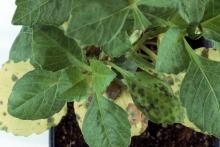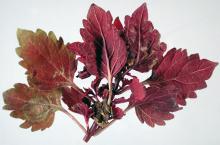See:
Impatiens - Impatiens Necrotic Spot
Cause Impatiens necrotic spot virus (INSV), formerly the I strain of tomato spotted wilt virus. Affects more than 50 different greenhouse ornamentals. It is especially destructive to aster, begonia, chrysanthemum, cineraria, cyclamen, dahlia, exacum, fuchsia, gloxinia, New Guinea impatiens, pansy, and stephanotis. African violet, ageratum, calceolaria, coleus, delphinium, geranium, hosta, lobelia, marigold, petunia, primrose, sedum, snapdragon and verbena can also have problem with this virus. It is transmitted by thrips, especially by the western flower thrips. Immature thrips (larvae) get the virus when feeding on diseased plants and spread the virus as adults when feeding on healthy plants. The virus multiplies in the plant but may not be distributed evenly. INSV overwinters in infected plants such as weeds or those held over in greenhouses. These plants are reservoirs of the virus from which it can spread again in spring. If not recognized at an early stage, the entire greenhouse planting could be lost.
Symptoms TSW and INS symptoms can mimic those of fungal, bacterial, or other viral infections. Both viruses can produce necrotic (dead) spots on leaves, black or discolored areas that follow leaf veins, general or spotty chlorosis (yellowing), black or purple stem streaks or leaf spots, falling of leaves or buds, leaf distortion, blackening of young leaves and growing points, stunting, and colored spots, stripes, or rings on petals, leaves, or fruit. The ringspot symptom is often seen.
Plants infected while young are the most severely affected. Symptoms range from dramatically obvious to no symptoms at all under certain conditions. Most infected plants tend to show the most obvious symptoms during cool weather or low light. An infected plant may not display symptoms at all during warm, high-light, rapid-growth periods. It is also common to find infected plants with only a few symptomatic portions while most of the plant looks normal.
Cultural control
- Have suspected diseased plants tested for the virus. On-site tests are commercially available to detect this and several other viruses.
- If the virus is present, destroy all infected plants and remove them and their potting soil (which contains the thrips' pupae) from the greenhouse range. Also rogue out any diseased plants as thrips are attracted to sick plants.
- Use light blue or yellow sticky traps to monitor thrips. Place one (1) sticky trap per 500 to 1,000 sq ft just above plants. Check traps weekly and keep accurate records of when and where thrips are trapped. WFT are more attracted to browallia (Browallia speciosa), gloxinia (Sinningia speciosa), impatiens (Impatiens wallerana), and verbena (Verbena x hybrida) than other floricultural crops.
- Keep vegetatively-propagated plant material separate from seed-grown plants, if possible, to reduce the chance of an unintentional introduction.
- Remove weeds under benches.
- Place indicator plants in each house where thrips may land. A number of petunia cultivars including Calypso, Summer Madness, and Super Blue Magic are good INSV and TSWV indicators. The fava bean 'Toto' also can be used.
- Separate greenhouse ranges with plastic barriers. Screen or net air intake vents. Use double-entry door construction.
- Workers should avoid wearing light-color clothing such as yellow, blue, and white.
Chemical control Sticky traps and spot treatments are part of an integrated control-monitoring program. Consult the PNW Insect Management Handbook for currently effective materials.
Reference Daughtrey, M.L., Jones, R.K., Moyer, J.W., Daub, M.E., and Baker, J.R. 1997. Tospoviruses strike the greenhouse industry: INSV has become a major pathogen on flower crops. Plant Disease 81:1220-1230.



